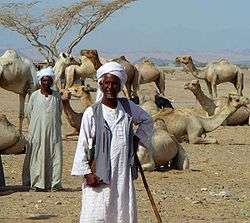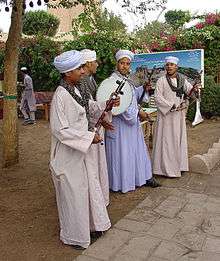Jellabiya
The Jalabiya or "galabeya" (Arabic: جلابية / ALA-LC: jilabīyah Egyptian Arabic: [ɡæ.læ.ˈbej.jæ, ɡæl.læ-]; "jelebeeya" in Ethiopia; "jehllubeeya" in Eritrea) is a traditional Egyptian garment native to the Nile Valley. The same term used to refer to the traditional Sudanese and Eritrean clothes, but both look different from the popular Egyptian garment which is worn by both Egyptian males and females and is much more colorful.


It differs from the Arabic thawb in that it has a wider cut, no collar (in some cases, no buttons) and longer, wider sleeves. In case of farmers, these sleeves can be very wide and sewn into pockets. They are then used to store small items such as tobacco or money. Along the Red Sea coast of Egypt and Sudan as well as the Sinai peninsula, most Bedouin and some Badawi tribesmen prefer the Arabian style dishdash or thobe over the Nile Valley jellabiya because of the latter's association with farming.
Jellabiya colors are often white in the summer. During winter, thicker fabric in other colours such as grey, dark green, olive, blue, tan or striped fabrics are used and colorful scarves worn around the neck. The garment is traditionally worn with an ammama (Arabic: عمامة; Egyptian Arabic: عمة IPA: [ˈʕem.mæ]) (turban).